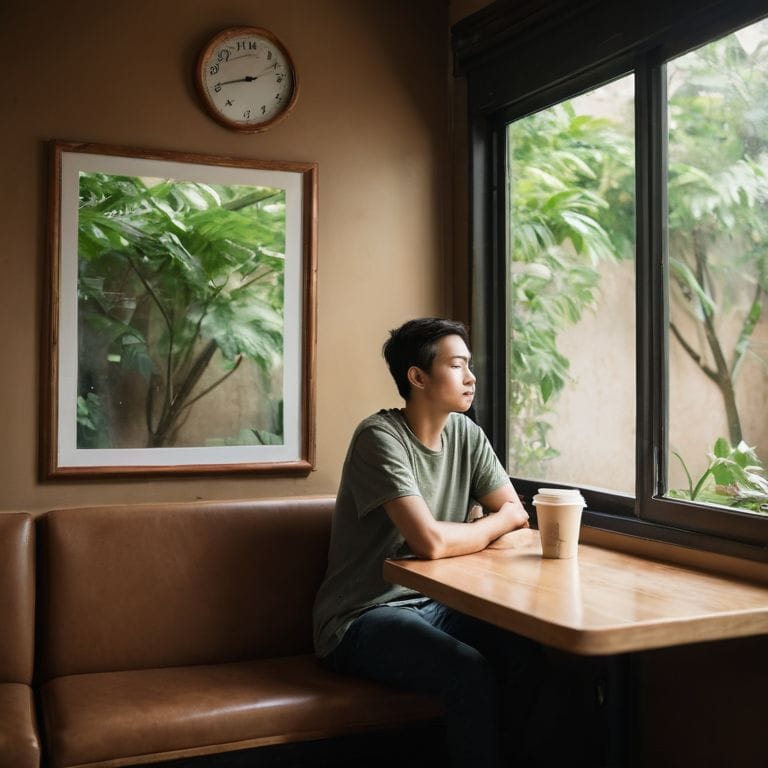As I sit in my garden, surrounded by the soothing sounds of nature, I often think about the social anxiety vs introversion debate. It’s a topic that has sparked much discussion, and yet, many people still struggle to understand the difference. I’ve seen friends and clients alike feel frustrated and confused by the overlapping symptoms, wondering if they’re simply introverted or if they’re struggling with something more. It’s a question that has weighed heavily on my mind, and one that I believe deserves a more nuanced and compassionate approach.
In this article, I promise to cut through the hype and offer a no-nonsense guide to understanding the subtle differences between social anxiety and introversion. I’ll draw from my own experiences as a therapist and mindfulness coach to provide practical advice and real-life examples that will help you better navigate your own emotions and behaviors. My goal is to create a safe and non-judgmental space for you to explore your feelings, and to offer actionable tools that you can use to cultivate greater self-awareness and peace in your daily life. By the end of this journey, I hope you’ll have a deeper understanding of yourself and the social anxiety vs introversion landscape, and that you’ll be empowered to make positive changes that will bring you greater joy and fulfillment.
Table of Contents
- Embracing Social Anxiety vs Introversion
- Finding Peace in Social Anxiety vs Introversion
- Navigating the Quiet: 5 Essential Tips for Understanding Social Anxiety vs Introversion
- Key Takeaways for Navigating Social Anxiety and Introversion
- A Gentle Insight
- Embracing the Journey to Self-Discovery
- Frequently Asked Questions
Embracing Social Anxiety vs Introversion

As I sit in my Japanese rock garden, surrounded by the serene sounds of nature, I often reflect on the distinguishing characteristics of social anxiety and introversion. It’s fascinating to see how these two concepts, although distinct, can sometimes intertwine like the branches of a tree. Embracing our true nature, whether introverted or extroverted, is crucial for our well-being. I’ve found that many of my clients who are introverted often possess introverted personality traits and strengths, such as being great listeners and observers, which can be incredibly valuable in both personal and professional settings.
When it comes to managing energy levels in social situations, I always advise my clients to take a step back and assess their needs. Just as a landscape watercolor painting requires balance and harmony, our social interactions require a balance between engagement and rest. Coping mechanisms for introverts in extroverted environments can be as simple as taking a short walk or finding a quiet spot to recharge. By acknowledging and honoring our energy levels, we can navigate social situations with greater ease and confidence.
In my experience, overcoming social anxiety in public often begins with small, gentle steps. I encourage my clients to start by engaging in low-stakes interactions, such as chatting with a stranger in a park or striking up a conversation with a cashier. By building confidence in these small ways, we can begin to manage our anxiety and develop a greater sense of comfort in social situations. As we walk through life, we can learn to appreciate the beauty of our own unique pace and rhythm.
Distinguishing Anxiety From Introverted Nature
As we navigate the subtle differences between social anxiety and introversion, it’s essential to recognize that introverted individuals often recharge their energy by being alone, whereas those with social anxiety may avoid social interactions due to fear or apprehension.
To distinguish between the two, consider the concept of self-reflection, allowing yourself to quietly examine your feelings and motivations, much like taking a peaceful walk to clear your mind.
Managing Energy in Social Situations
As we navigate social situations, it’s essential to recognize how our energy levels are affected. For individuals with social anxiety, conserving energy becomes a vital strategy to prevent feeling overwhelmed. This might involve taking short breaks from crowded rooms or setting boundaries around social engagements.
By being mindful of our energy expenditure, we can prioritize self-care and make intentional decisions about how we engage with others. This might mean choosing smaller, more intimate gatherings over large parties or opting for one-on-one conversations instead of group settings.
Finding Peace in Social Anxiety vs Introversion

As we navigate the complexities of social interactions, it’s essential to recognize the importance of self-awareness in understanding our unique personalities and needs. For introverted individuals, managing energy levels in social situations can be a crucial aspect of maintaining their mental well-being. By acknowledging and respecting their boundaries, they can learn to thrive in environments that might otherwise feel overwhelming.
In contrast, individuals struggling with social anxiety may experience a profound sense of discomfort in public, which can be mistaken for introversion. However, it’s vital to distinguish between these two concepts, as social anxiety often involves a deeper-seated fear of judgment or rejection. By developing effective coping mechanisms, such as mindfulness and relaxation techniques, individuals can begin to overcome their social anxiety and feel more at ease in public.
Ultimately, finding peace in social situations requires a deep understanding of our own strengths and weaknesses. For introverts, this may involve embracing their natural reserve and prioritizing solo activities that bring them joy. By doing so, they can recharge and feel more confident in their interactions with others, allowing them to nurture meaningful relationships without feeling drained or overwhelmed.
Coping Mechanisms for Introverts in Public
As an introvert, being in public can sometimes feel overwhelming. I’ve found that having a few trusted coping mechanisms can make all the difference. For me, taking a short walk outside can help calm my mind and recharge my energy.
In crowded spaces, I recommend setting boundaries to protect your personal space and energy. This might mean taking a break from the crowd or finding a quiet spot to collect your thoughts. By prioritizing your own needs, you can navigate public situations with greater ease and confidence.
Overcoming Shyness and Anxiety Differences
As we navigate the subtle differences between social anxiety and introversion, it’s essential to recognize that shyness can often be a common thread. I’ve seen many individuals struggle to express themselves in social situations, fearing judgment or rejection. This can lead to a vicious cycle of self-doubt and withdrawal.
To break free from this cycle, it’s crucial to focus on building self-compassion. By acknowledging and accepting our emotions, we can begin to develop a more gentle and understanding relationship with ourselves. This, in turn, can help us to slowly build confidence and become more comfortable in our own skin, allowing us to engage with others in a more authentic and meaningful way.
Navigating the Quiet: 5 Essential Tips for Understanding Social Anxiety vs Introversion
- Take a 10-minute walk to clear your mind before social gatherings, allowing yourself to breathe and calm your nerves, just as a gentle stream clarifies its waters with patience
- Practice self-compassion by acknowledging that your introverted nature is not a flaw, but a unique aspect of your personality, much like the intricate patterns found in a Japanese rock garden
- Learn to distinguish between social anxiety and introversion by recognizing that anxiety often stems from fear, while introversion is a natural preference for quieter environments, like a tree seeking shade
- Develop coping mechanisms, such as deep breathing exercises or creative expression, to manage energy in social situations and find your own peaceful rhythm, just as a landscape watercolor painting requires balance and harmony
- Embrace your need for alone time, allowing yourself to recharge and reflect, just as the stillness of a forest after a snowfall enables the trees to rejuvenate and grow stronger
Key Takeaways for Navigating Social Anxiety and Introversion
Understanding the distinction between social anxiety and introversion is crucial, as it allows individuals to address their specific needs and develop tailored coping strategies
Embracing and managing energy in social situations can significantly impact one’s ability to navigate both introverted tendencies and social anxiety, promoting a healthier and more balanced approach to social interactions
By acknowledging and working with their unique characteristics, individuals can develop effective mechanisms to cope with social anxiety and introversion, ultimately finding peace and comfort in their own quiet way
A Gentle Insight
Just as a river flows gently to its destination, not forcing its way, we can learn to navigate social situations with the same ease, understanding that being an introvert is not a barrier, but a unique path to connection and peace.
Dr. Samuel Cole
Embracing the Journey to Self-Discovery

As we conclude our exploration of social anxiety vs introversion, it’s essential to remember that understanding the difference between these two concepts is crucial for personal growth. We’ve discussed how to distinguish anxiety from introverted nature, and explored strategies for managing energy in social situations. By acknowledging and accepting our unique needs and boundaries, we can begin to find peace in the quiet and cultivate a more compassionate relationship with ourselves. Whether you’re an introvert or someone who experiences social anxiety, it’s vital to recognize that your feelings are valid and deserving of care.
As you move forward on your journey, I encourage you to embrace the beauty of your inner world. Remember that a 10-minute walk can be a powerful catalyst for clarity and insight. By taking small, gentle steps towards self-awareness and self-acceptance, you can unravel the gentle difference between social anxiety and introversion, and discover a deeper sense of peace and belonging. May you walk in the serenity of nature, and may your heart be filled with kindness, compassion, and understanding for yourself and others.
Frequently Asked Questions
How can I tell if my preference for alone time is due to introversion or social anxiety?
Let’s explore this together – when I’m walking in nature, I notice how some paths are meant for solitude, while others invite connection. Similarly, ask yourself: do you recharge in alone time, feeling refreshed, or do you avoid social situations due to fear or apprehension? This subtle distinction can help you understand whether your preference for alone time stems from introversion or social anxiety.
Are there any specific strategies for managing social anxiety in group settings without feeling overwhelmed?
When I’m working with clients on managing social anxiety in groups, I often suggest taking a ‘breathing break’ – stepping outside for some fresh air or finding a quiet corner to collect your thoughts. This simple act can help calm your nervous system and prevent feeling overwhelmed, much like a tree weathering a storm by flexing its branches.
Can being an introvert with social anxiety affect my ability to form and maintain meaningful relationships?
As someone who’s worked with many introverts with social anxiety, I’ve seen that it can indeed present challenges in forming and maintaining relationships. However, with self-awareness, gentle communication, and a willingness to take small steps, it’s entirely possible to nurture deep and meaningful connections with others.
